SACRAMENTO – The Stephon Clark protest on March 22 was scheduled to be a demonstration at Sacramento City Hall with brief marches in and out of Cesar Chavez Park, which is right across the street.
After three hours of marching, speeches and waving signage of their displeasure of the 22-year-old man being shot at 20 times in the back yard of his grandparents’ house in South Sacramento, the protesters — hundreds of them — were about to call it a day.
Before ceasing the operation, it clicked in some of the organizers’ minds that they had to visit one more location in downtown Sacramento. It was a brilliant move, too.
“The energy was up and we were about to come back to City Hall and end everything,” said Berry Accius, founder of Voice of the Youth and one of the main organizers alongside Black Lives Matter Sacramento. “But then folks were like, ‘You know what, let’s go to Golden 1 (Center). Let’s make an uncomfortable situation for those folks who believe that this situation has nothing to do with them.”
Accius refers to the moment as being an “organic” strategy. So much so, that the demonstration did wake up Sacramento and the rest of the country. Golden 1 Center was completely shut down. Security would not let anyone enter or exit the building.
For a short time, actually right up until tip-off of the game, the Kings and the Atlanta Hawks were not sure they would play the game. But they did, before 2,400 fans that did get inside of G1C before the protesters pushed their way onto the Downtown Commons plaza known as David J. Stern Way.
As Kings fans waited outside of the front entrance, protesters locked arms to form a human chain around G1C. Every entrance to the facility was under siege because of one quick idea that made a big difference.
“I feel like it was beautiful. I feel like we did the right thing,” said Black Lives Matter Sacramento founder Tanya Faison. “Every step that we took, we did the right thing and everything was led by the people. Anything that we go into I get the energy and we go with that.”
The energy was so great that before getting to the arena, Black Lives Matter Sacramento and a horde of unified social groups took their march to the freeway, specifically Interstate 5. At peak hours, the
freeway traffic was halted. Ms. Faison has led many protest marches in the last few years — this one was monumental.
But she said the circumstances needed something special.
“It’s been happening over and over again,” Ms. Faison told The OBSERVER of the police-involved shootings of Black men in Sacramento. “It has to change. There is going to be some changes. We are at this point now to where we are tired of anything that you bring to us that is not what we need. We’re not accepting it. Period and point blank,” she added.
People such as Accius, Faison, Jamier Sale, Keon Johnson, Sacramento Area Congregations Together, and many more have been protesting and bringing awareness to these shootings for years. They meet privately and publicly in concerted effort to force police departments to change their policies.
A few battles have been won while a lot more have been lost. Ms. Faison told the Sacramento City Council on March 20, two days after
Clark was killed in a hail of gunfire, that she was “tired” because she had faced them before, again and again. But she and Accius are in the game for the long haul.
“Throughout this time I have been in social activism, I’ve always said about these real core issues, especially with Colin Kaepernick and far back when Donald Sterling said those things about the L.A. Clippers, the way you make people feel you is when you shut down that entertainment,” Accius said. “So what we showed is that this is what it looks like if the players decided not to play. It was always the strategy that I had in my mind.”
Ms. Faison and Accius want it know that they were not behind the second shutdown of Golden 1 Center when the Kings played the Dallas Mavericks on March 27. That incident was put on at the last minute by protesters who left Tuesday’s City Council meeting.
They also said that they would not organize any more demonstrations at G1C. But there are no guarantees that it would be the end of the protests there.
_____
By ANTONIO R. HARVEY
OBSERVER Staff Writer
